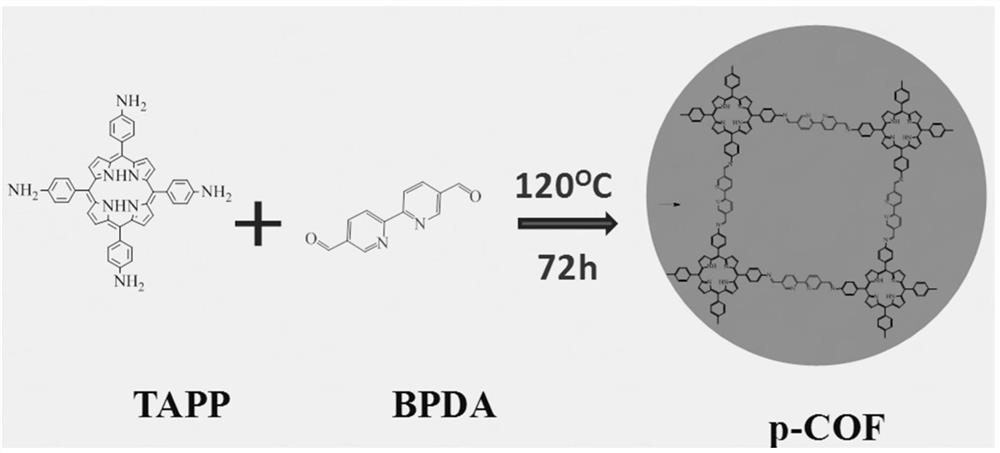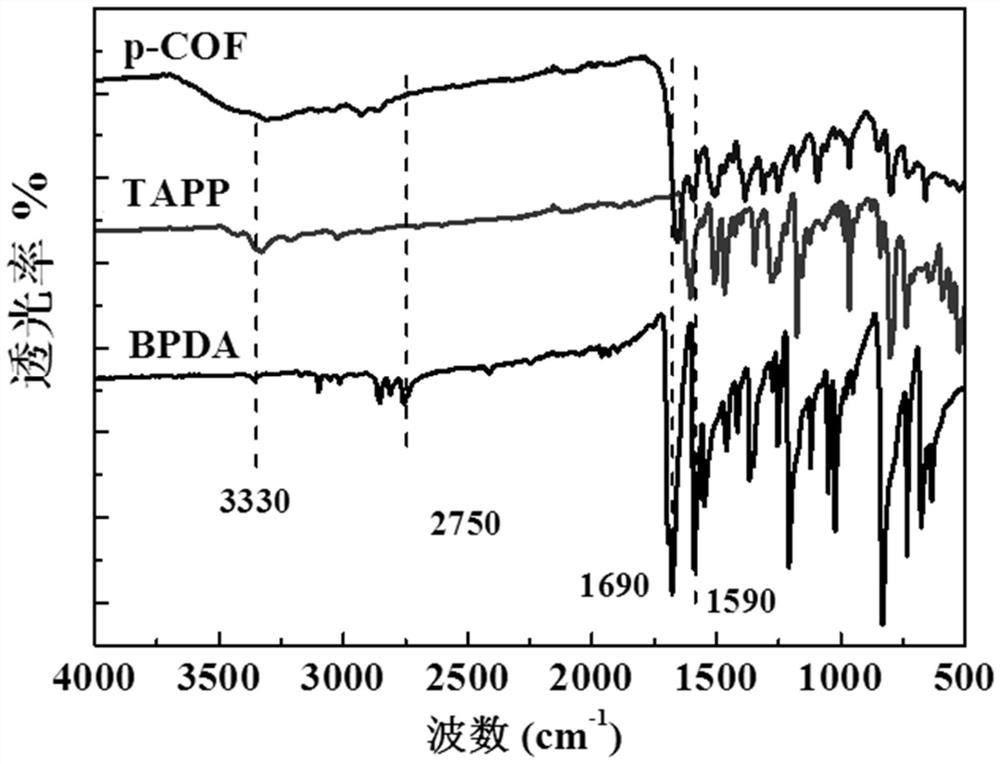Covalent organic framework material, preparation method and application thereof, aptamer sensor and preparation method thereof
A covalent organic framework and aptamer sensor technology, applied in the field of electrochemical sensing, can solve the problems of unsatisfactory sensitivity and cumbersome manufacturing process of electrochemical biosensors
- Summary
- Abstract
- Description
- Claims
- Application Information
AI Technical Summary
Problems solved by technology
Method used
Image
Examples
preparation example Construction
[0070] Preparation of phosphate buffer solution: 8.00g NaCl, 0.20g KCl, 1.44g Na 2 HPO 4 , 1.8g K 2 HPO 4 Dissolve in 800mL ultrapure water (≥18.2MΩ·cm), adjust the pH value of the solution to 7.4 with hydrochloric acid, and finally dilute to 1L with ultrapure water (≥18.2MΩ·cm) to obtain a phosphate buffered saline solution (PBS, 0.01mol / L, pH=7.4).
[0071] Preparation of electrolyte solution: 1.6g K 3 Fe(CN) 6 , 2.1 g K 4 Fe(CN) 6 and 7.5g KCl were added to the above-prepared phosphate buffer solution (PBS, 0.01mol / L, pH=7.4) to obtain an electrolyte solution, which was used for the electrochemical detection of the aptasensor.
[0072] Preparation of N58 aptamer solutions with different concentrations: Add phosphate buffer solution (PBS, 0.01mol / L, pH=7.4) to the stock solution of N58 aptamer, and prepare the concentrations of 1, 10, 50, 100 and 200nmol / L, respectively. L of N58 aptamer solution.
[0073] Preparation of N-gene solutions with different concentration...
Embodiment 1
[0077] The covalent organic framework material of this example consists of 5,10,15,20-tetraamine (4-aminophenyl) porphyrin (TAPP) and 2,2'-bipyridine-5,5'-dicarbaldehyde (BPDA ) is prepared by a Schiff base reaction under the action of a catalyst; wherein, the temperature of the Schiff base reaction is 120°C, the reaction time is 72h, the molar ratio of TAPP and BPDA is 23:41, and the Schiff base reaction The solvent of the alkali reaction is composed of o-dichlorobenzene and n-butanol, the volume ratio of the o-dichlorobenzene and n-butanol is 1:1, and the catalyst is acetic acid.
[0078] Two, the specific embodiment of the preparation method of the covalent organic framework material of the present invention is as follows:
Embodiment 2
[0080] The covalent organic framework material prepared by the method for preparing the covalent organic framework material in this example is the covalent organic framework material in Example 1, and the specific steps are as follows:
[0081]5,10,15,20-tetraamine(4-aminophenyl)porphyrin (TAPP) (15.6 mg, 0.023 mmol) and 2,2'-bipyridine-5,5'-dimethylaldehyde (BPDA) ( 8.7 mg, 0.041 mmol) was added into a Schlenk bottle (15 mL in volume) containing 2.5 ml o-dichlorobenzene and 2.5 ml n-butanol, the solution was dark green at this time, then the Schlenk bottle was placed in an ultrasonic cleaner, and passed Shake ultrasonically for 30 minutes to form a homogeneous solution, and add 0.2 mL of acetic acid solution with a concentration of 6 mol / L as a catalyst. Under the protection of nitrogen, the air in the reaction bottle was removed through three cycles of freezing-pumping and thawing, and the reaction was carried out at a temperature of 120° C. for 72 hours. After the reaction...
PUM
| Property | Measurement | Unit |
|---|---|---|
| pore size | aaaaa | aaaaa |
| recovery rate | aaaaa | aaaaa |
Abstract
Description
Claims
Application Information
 Login to View More
Login to View More - Generate Ideas
- Intellectual Property
- Life Sciences
- Materials
- Tech Scout
- Unparalleled Data Quality
- Higher Quality Content
- 60% Fewer Hallucinations
Browse by: Latest US Patents, China's latest patents, Technical Efficacy Thesaurus, Application Domain, Technology Topic, Popular Technical Reports.
© 2025 PatSnap. All rights reserved.Legal|Privacy policy|Modern Slavery Act Transparency Statement|Sitemap|About US| Contact US: help@patsnap.com



